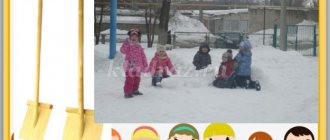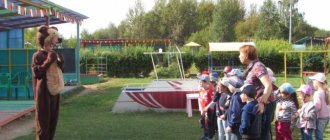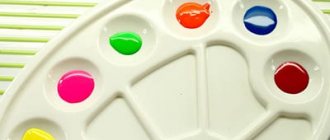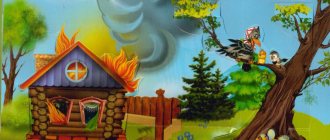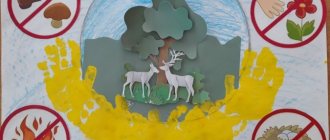Senior group. Senior preschool age. Children 5-6 years old
Summary of valeology lesson in the senior group “Take care of your health!” "Take care of your
health !" Summary of the valeology lesson in the senior group Prepared by the physical education instructor "MDOU Kindergarten in the village of Storozhevka, Tatishchevsky district, Saratov region"
YAKUBOVICH ALLA GENNADEVNA Goal: to form in children a conscious attitude towards...
Summary of a lesson in valeology for children of senior preschool age “Path of Health” Summary of a lesson in valeology for children of senior preschool age “Path of Health ”
Program content: - teach children to take care of their
health . -improve skills in using personal hygiene items. -explain to children the benefits of the sun, air and...
Summary of an open lesson on valeology for the senior group “Journey to the Land of Health”
Educator: Well, guys, let's hit the road. Look, the poster shows a human body, let's make sure you know all the parts of the body. (The teacher names: arms, legs, neck, knees, elbows, etc.)Educator: Who are these terrible creatures around the human body? Educator: Are microbes dangerous for humans? Educator: Indeed, the microbe is a terribly harmful animal: insidious and, most importantly, ticklish. Such an animal will crawl into your stomach and live there quietly. He will climb, the scoundrel, wherever he wants. He will walk on the patient and tickle him. He is proud that he causes so much trouble: And a runny nose, and sneezing, and sweat. We absolutely must save this boy. Guys, what are microbes afraid of? Educator: How do microbes get into our body? Educator: You answered correctly. If you do not wash your hands before eating or put unwashed food into your mouth with dirty hands, then germs can enter the human body along with the dirt. We can also inhale air contaminated with microbes, but there is an obstacle in the way of the microbes - our nose. The human nose is designed in such a way that the air passing through it is warmed and purified. Therefore, it is best to breathe through your nose. And also, in order for our nose to strengthen, we must do special exercises. Let's do this exercise. - stroke your nose from tip to bridge, inhale, and as you exhale, tap the wings of your nose with your index fingers; - take 8-10 inhalations and exhalations through the right nostril, then through the left, in turn, closing the resting one with the index finger; — inhale through your nose, and as you exhale, draw out the sound mmmm, while simultaneously tapping your fingers on the wings of your nose; - while exhaling, open your mouth wide and stick out your tongue as far as possible, trying to reach the chin with the tip, while silently saying a-a-a
Well, now you understand why babies need a nose! I really need every nose, since it has grown to my face. In the hot summer, on the meadow, the nose smells the flowers. In the clearing, strawberries. In the garden bed, ripe strawberries. In the garden, the nose smells where the garlic and onions have grown. Educator: And now the next riddle from Vitaminka: She gave us sounds that we must guess. (Various sounds are included)
Educator: Well done, you guessed all the sounds, but with what help do we hear and distinguish sounds? Educator: You also need to protect and care for your ears. What can harm our ears? Educator: Now let's play with the ears so that they are strong too. (massage of biologically active points) Come to me, my friend, And quickly sit down in the circle Find your ears And show me quickly. That's how we clap our ears, Now we'll pull everything down. Ear, don't fall off. And then, and then They twisted the tragus. The ear seemed to be frozen, so you can warm it up. So the game ended. There was silence.
Educator: tell me, what do we need eyes for?
Do you need to take care of your eyes?
Who do we go to for eye exams?
Exercise for the eyes.
Working with pictures (indicate with an arrow what the eye sees, what the nose feels, what the ear hears). Educator: look, again some drawings - Vitaminka prepared riddles for us. What could they mean?
Presentation of healthy lifestyle
Educator: again everyone guessed: To be strong and agile, you need to be friends with the sun. In the morning, get up before everyone else and do exercises. Everyone knows, everyone understands that it’s nice to be healthy. The sun, air, sports, water are our best friends.
Educator: And now another riddle of Vitaminka. What do you think this is? (a model of a diseased tooth is placed on the easel) Educator: Yes, this is a spoiled diseased tooth, in which microbes also live. Why did the tooth deteriorate? Educator: Let's check if you know which foods are healthy and which are harmful to your teeth?
Educator: Do you know how to brush your teeth properly? How many times a day?
Showing pictures of healthy and diseased teeth.
Educator: You should also not chew hard objects and you need to visit the dentist on time. Then terrible toothache and harmful microbes will never be able to settle in your beautiful healthy teeth. Here we seem to have arrived. (Vitaminka appears from behind the screen) Vitaminka: Hello, guys, you are so great. All my riddles were solved. Do like the bunnies, girls and boys. In the morning, get up at the crib, quickly do exercises. After washing thoroughly, sit down at the table as soon as possible. And after breakfast, the bunnies - these friendly guys - always brush their teeth with a brush and toothpaste for 3 minutes, then run to the kindergarten, but don’t bite the sweet sugar. Hares take care of their teeth. Hares love to eat apples and pears, and delicious carrots and crunchy cabbage, and, of course, milk, cow's milk. After all, everyone knows that it contains strength and health. After the garden, the whole crowd returns home. At home, a delicious dinner awaits them - cabbage soup with fresh cabbage. The hares quickly eat everything and want to wash themselves, rinse their mouths with water, and go for a walk with their mother. You guys try to do the same as the bunnies and then the toothache will leave you forever.
Educator: Vitamin, our children also know a few tips that must be followed in order to be healthy.
Valeological education of children in a preschool educational institution
This article discusses the main tasks of valeology, its direction and purpose, as well as methods and techniques in valeology classes. This article will help preschool teachers see the need to introduce preschoolers to a healthy lifestyle.
Key words: valeology, health, healthy lifestyle, health culture, teaching, personal hygiene, healthy lifestyle, Federal State Educational Standard.
In order to understand whether it is necessary to use valeology in a preschool institution, it is necessary to understand what “valueology” is and where did this concept come from?
Valueology is the science of the art of being healthy, maintaining health, leading an active and healthy lifestyle, which must be learned from an early age.
The word “valeology” comes from the Latin word: “valeo” - to be healthy.” This term was introduced into scientific circulation by the Russian pharmacologist, Doctor of Medical Sciences, Professor Brekhman, Israel Itskovich, he became the creator of a new branch of medicine - valeology, and Brekhman is also the inventor of many medications.
Valeology includes several components: medicine, pedagogy, psychology, hygiene, physical education, social studies, ecology, biology, life safety.
In preschool institutions, this science has become one of the priority areas of the educational process for preschoolers.
Health has always been and will be in first place, therefore the central problem of valeology is the attitude towards individual health and the cultivation of a culture of health in the process of individual development of the child’s personality.
“Valeology is an interscientific direction of knowledge about human health, about ways to ensure it, form and preserve it in specific conditions of life. As an academic discipline, it represents a body of knowledge about health and a healthy lifestyle. E. N. Weiner" [4]
The goal of valeology in preschool educational institutions is to develop health and expand the reserve capabilities of the body of children from an early age, increasing the quantity and quality of health.
Weiner Eduard Naumovich identified the main tasks of valeology :
- Research and quantitative assessment of human health and health reserves.
- Formation of an attitude towards a healthy lifestyle.
- Preservation and strengthening of human health and health reserves through introducing him to a healthy lifestyle [1].
The subject of valeology is individual health and human health reserves, as well as a healthy lifestyle. This is one of the most important differences between valeology and preventive medical disciplines, the recommendations of which are aimed at preventing diseases.
From the outside it may seem that this science does not contain anything complicated. However, it is not. After all, valeology considers health comprehensively, holistically, including all its sides and aspects and studying it from all sides and options. Due to the global nature of the concept, valueology is associated with a whole complex of other sciences.
According to the Federal State Educational Standard, the educational field is aimed at achieving the goals of protecting children's health and forming the basis of a culture of health by solving the following tasks:
- Preservation and strengthening of children’s physical and mental health
- Education of cultural and hygienic skills
- Formation of initial ideas about a healthy lifestyle [2].
Raising a valeological culture in children means creating motivation for the formation, preservation and strengthening of health.
The valueological culture of a preschooler implies:
– knowledge about your health;
– conscious attitude towards human health and life;
– the ability to protect, maintain and maintain health;
– valeological competence.
The Federal State Educational Standard (FSES) identifies the main areas of valnology:
– Human structure.
– The importance of healthy food.
– How to maintain your health. [2]
The direction of work of valeological education of preschool children should be implemented not only within the framework of direct educational activities (DEA) (in the classroom), but also during the organization of: leisure activities, entertainment, matinees, walks, and routine moments.
The main allies of the teacher in maintaining the health of the preschooler are the parents. Interaction with parents is necessary, as they are the standard for the child. The teacher needs to convey to them the importance and need to participate in raising the health of their children. To do this, it is necessary to conduct consultations on the topic of “health”; events together with parents “mom, dad, me - a sports family”, etc.
Methods and techniques in valeology classes:
Regardless of the nature of the educational activity, the teacher uses a combination of techniques from four groups of methods (verbal, visual, practical, game).
Verbal method - in a preschool institution, speech is important not only as a means of learning, but also as a way of communication. For younger groups, this means faster speech development, and for older groups, an expansion of vocabulary.
- dialogue
– conversation (reasoning)
– explanations
– reading literature
Visual method - the use of visualization is necessary for the successful implementation of the objectives of the educational process. Since preschool children perceive information only when accompanied by illustrations.
– observation
– display (examination of paintings, illustrations)
– demonstration (slides, filmstrips, films)
Practical method - The techniques of this method involve the child’s practical mastery of reality.
– drawings
– applications
– crafts
– experiments
The game method allows preschoolers to master entire blocks of new valeological knowledge, skills and abilities.
– didactic
– movable
– theatrical
Innovative method - allows the child to move with the times, master new games, developing logic, thinking, fine motor skills, etc.
– Montessori
– fairytale therapy
– sand therapy
– TRIZ, etc.
Valueology in kindergarten is very important in the education of the future schoolchild. This science teaches preschoolers to take care of their health and strengthen their body, preventing possible diseases. Since valeology includes a whole complex of sciences, children, in addition to taking care of their bodies, learn to correctly express their emotions and feelings, taking care of their psycho-emotional state. They learn not to be afraid of the dangers around them, but to beware of them and look for ways to eliminate them, and also develop the need to take care not only of themselves, but also of the people around them.
Literature:
- Weiner E. N. Valeology: Textbook for universities. 2001. - M.: Flinta: Nauka, 2001. - 416 p.
- Federal State Educational Standard for Preschool Education (approved by order of the Ministry of Education and Science of the Russian Federation dated October 17, 2013 No. 1155, registered with the Ministry of Justice of Russia on November 14, 2013 No. 30384) access mode: //www/firo.ru/? page_id=11678
- From birth to school. Approximate general educational program for preschool education / Ed. N. E. Veraksy, T. S. Komarova, M. A. Vasilyeva. — M.: MOSAIKA$SYNTHESIS, 2014. — 334 p.
- “Valeology: a textbook for universities,” 2016 (quote from the Google Books library).
Preview:
Developed and conducted by L.V. Yanpolskaya, senior teacher
Purpose: 1. Give children the concept of sleep. Show the meaning of sleep in a person’s life;
Objectives: 1. Explain to children the physiology of sleep; 2. Familiarize yourself with the basic hygienic rules of sleep. 3. Develop hygiene skills and abilities of children. 4. Cultivate a sense of responsibility in yourself so as not to disrupt your daily routine. 5. Activation of the dictionary: Dream bag, clothespins, jug.
Preliminary work: 1. Introduction to bedding. 2. Visit to the laundry room in kindergarten. 3. Exhibition of children's drawings “Magic Dreams”. 4. Children's games with dolls. 5. Selection of folk lullabies: “Tired toys are sleeping” (lyrics by Z. Petrova, music by A. Ostrovsky)
Equipment: 1. Sleep hygiene support charts, 2. illustrated pictures with toiletries, 3. children's beds, 4. dolls, 5. pastels, 6. audio cassettes, 7. art books.
Methodical techniques: 1. Surprise moment; 2. Exhibition of hygiene products; 3. Poems; (S. Marshak “Here under your back”, “Lullaby”, V. Nesterenok “Tricky pillow”, F. Pestryakov “Blizzards are rustling outside the window” 4. Problem situation “Sleep hygiene” 5. Physical exercise; 6. Games; 7. Guessing riddles 8. Summary.
Program content: 1. Give the concept of first aid for sunstroke, heatstroke, fainting, insect bites, bleeding, fractures, poisoning; 2. Introduce artificial respiration techniques, its meaning and necessity. 3. Continue to introduce the circulatory system 4. Nurture the moral and volitional qualities of the individual, mercy, compassion, mutual assistance, mutual assistance. 5. Activation of vocabulary: Artificial respiration, dislocation, proteins, etc.
Preliminary work: 1. Invite the head nurse to the group and talk about first aid, 2. Play the role-playing game “Ambulance”
Equipment: 1. telephone, 2. medical bag, 3. table “Providing first aid; for fractures and dislocations”, 4. scarf, 5. doll, 6. pencil.
Methodical techniques: 1. Surprise moment “Ambulance”. 2. Problem situation “Providing first aid”. 3. Teacher’s story “Medicinal herbs.” 4. Practical “Artificial respiration” 5. Visual “Display of the first aid kit” 6. Physical exercise “Pinocchio”. 7. Games. 8. Summary.
Source
Abstract of OOD on the development of speech and valeology in the senior group “Our senses”
Three heavy ones. (eyes down)
The clouds said goodbye, the clouds are gone (cover your eyes with your palms)
The sun was shining in full force in the sky. (open your eyes wide)
- Guys, let's play. I brought jars of scent. Try to guess whose scent is “hidden”
in each of them.
Didactic game “Guess by smell”
Children identify the product (garlic, onion, perfume, orange)
and call him.
- How did you guess what was in the jars? (Using your nose)
.
Picture of Nose
Why does a person need a nose? (to breathe; the nose protects our body from dust and germs, etc.)
- And you also need it in order to speak beautifully. Pinch the nose with your fingers and repeat “no-na”
. What happened? The nose is responsible for the sense of smell. This is the main organ that helps us detect smell. Grandma is baking pies - does it smell good? Now take it and look at yourself in the mirror. See how you have little hairs in your nose? They are called cilia. They trap dirt, dust, viruses and other particles that we inhale through the nose along with air, thereby preventing them from entering the respiratory tract. Eyelashes also work to make you smell. We also need to take care of our nose, because it helps us so much.
Breathing exercises “Veterok”
I am a strong wind, I am flying,
I fly wherever I want (arms down, legs slightly apart, inhale through the nose)
I want to whistle to the left, (turn my head to the left, lips with a straw and blow)
I can blow to the right (head straight - inhale, head to the right, lips with a tube - exhale)
I can go up (head straight - inhale through the nose, exhale through the lips with a tube, inhale)
And into the clouds ( lower your head, touch your chin to your chest, calmly exhale through your mouth
)
In the meantime, I’m dispersing the clouds (circular movements with my hands)
.
— Another sense organ is the organ of hearing. What parts of the body belong to it? (Ears)
.
Picture of Ear
What do our ears do? Let's check what kind of hearing you have.
Game "Guess by ear"
(Children listen to different sounds and name who they belong to)
.
- Well done, you guessed everything. The ears are also an important sense organ. Thanks to our ears, you and I can hear the birds singing, the sea roaring, the rain pounding. How should you take care of your ears? (wash, clean, put on a hat if it’s cold, etc.)
— And also, in order to keep our ears healthy, they massage our ears. Let's do everything together.
Self-massage of the auricle
(performed with the thumb and index fingers - the thumb is at the back)
Grab your ears by the tops (with your thumb and forefinger on both sides)
Pull... (pull up slightly)
They pinched... (light pressure with fingers, with gradual
We ran down to the lobes. moving down)
Planning GCD for valeology
Classes on mastering the theory of health in the senior group are held once a week, and the goal is set for the whole month. In this case, integrated (!) lessons are usually held, that is, those in which the topic is revealed in the process of involving children in different types of activities. This principle of constructing lessons is reflected in the long-term plan, which is drawn up by the teacher for the school year.
Table: long-term plan for valeology in the senior group (fragment)
| Month | Goals | Activities with goals |
| September |
| Didactic game: “I can - I can’t”, like “Edible - inedible”. Goal: to maintain in children a joyful mood and a sense of wonder and pride in their almost limitless abilities. Drawing on the topic: “What am I made of?” Goal: to find out how children imagine their self, their body, their organs. Reading fiction about cleanliness: K. Chukovsky “Moidodyr”, Agnia and Pavel Barto “Grubby Girl”. Goal: to consolidate cultural and hygienic skills with children. |
| October |
| Conversation with a doctor about diseases of dirty hands and skin diseases, preventive measures. Goal: to bring children to an understanding of the direct relationship between cleanliness and health. Art activities on the topic of read works. Exhibition of drawings. Goal: to express your attitude towards dirty people, both indirectly and verbally. Labor assignments to maintain cleanliness in the group. Goal: to cultivate hard work, a negative attitude towards disorder and dirt in the room. Leisure time on the topic: “Skin is a helper.” Goal: consolidate, deepen acquired knowledge, develop logical thinking. |
| November |
| Lesson "Skeleton and muscles". Goal: to give children an idea that every person has bones inside that make up a movable structure - the skeleton of our body. Didactic game: “Dangerous - not dangerous.” Goal: to develop protective self-awareness, to anticipate the possible consequences of one’s actions. Reading fiction: A. Barto “I am growing”, S. Marshak “The Giant”. Goal: to cultivate a sense of compassion for the misfortune of one’s neighbor, a desire to help, and to bring joy. Design and modeling from the book by G. Yudin “The Main Wonder of the World”. Goals:
|
The long-term plan stipulates different types of work on specific topics in valeology
